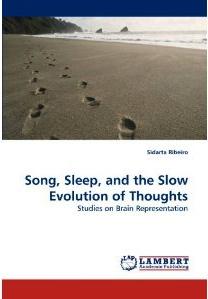
Song, Sleep and the Slow Evolution of Thoughts. Saarbrücken, Lambert Academic Publishing, 2009.
How do brains change their sensorimotor representations of the objects of the world in an adaptive manner, i.e. how do brains learn? In order to experimentally address this question, mapping of the plasticity-associated immediate early gene ZENK was applied to two different neurobiological questions, the memorization of songs by songbirds, and the role of sleep in the consolidation of daytime memories. In chapter one the author shows that NCM, a song-responsive canary forebrain nucleus, carries a well-ordered topographic representation of the species-specific syllabic repertoire. This representation is tuned to natural features of the stimuli, can be modified by experience, and depends dynamically on attention. In chapter two Ribeiro demonstrates that ZENK expression, which is downregulated during slow-wave and REM sleep in the brains of cage-reared rats, is reinduced during REM sleep in the cerebral cortex and the hippocampus of rats exposed to an enriched environment in the preceding waking period. This result can also be obtained by substituting enriched environment exposure for induction of hippocampal long-term potentiation, suggesting that REM sleep that follows an enriched waking experience is a window of increased neural plasticity. Finally, chapter three presents a theoretical effort to set boundaries to the question of what a brain representation, or thought, might be. It is hypothesized that a thought is a self-propagated wave of electrical activity along a particular recursive trajectory in the neuronal matrix. This hypothesis is used to build a plausible historical narrative of the biological evolution of thoughts, which explains many presently disjointed mind and brain facts, with particular applicability to the understanding of learning.
